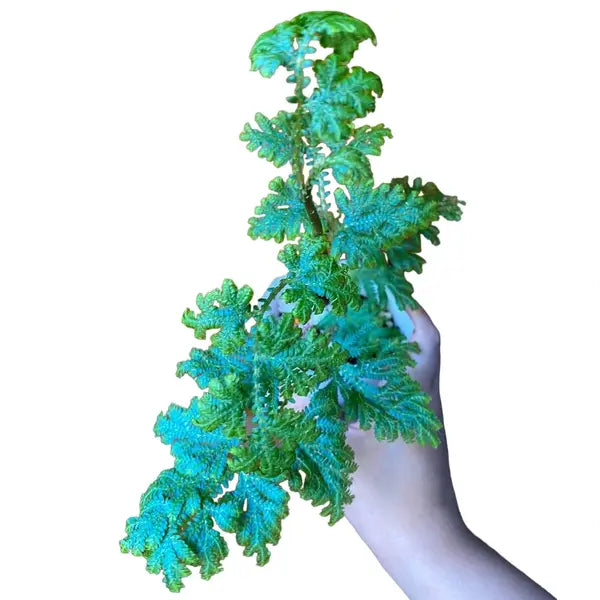Blue Peacock Fern, Selaginella Willdenowii, Selaginella uncinata - Very Rare
- Rs. 149.00
-
Regular price
Rs. 899.00 -
-83%
- Will be in stock after
Vendor: Jiffy Plants
Couldn't load pickup availability
Spend Rs 1499 for free shipping
Guarantee safe checkout


Blue Peacock Fern, Selaginella Willdenowii, Selaginella uncinata - Very Rare
Selling size: Single plant | 2.5" Pot Included
The Blue Peacock Fern, scientifically known as Selaginella uncinata or sometimes referred to as Selaginella willdenowii, is a captivating plant renowned for its vibrant, iridescent blue-green foliage. While not a true fern, it shares a similar growth habit and thrives in similar conditions. Here's a comprehensive guide to caring for this unique plant:
Blue Peacock Fern, Selaginella Willdenowii, Selaginella uncinata Care:
Light:
Indirect Light: Peacock Ferns prefer bright, indirect light. Avoid placing them in direct sunlight, as this can scorch their delicate foliage.
Low Light Tolerance: While they prefer brighter conditions, they can tolerate lower light levels, though their growth may slow down.
Ideal Locations: East- or north-facing windows are generally ideal. If you only have south- or west-facing windows, provide some shade during the hottest parts of the day.
Watering:
Consistent Moisture: Peacock Ferns require consistently moist soil. Allow the top inch or two of the soil to dry out slightly between waterings, but avoid letting it completely dry out.
Watering Methods: Water thoroughly until excess water drains from the bottom of the pot. Avoid overwatering, as this can lead to root rot.
Humidity: These plants appreciate high humidity levels. Consider misting them regularly, especially during dry periods or in dry climates. Alternatively, you can place the pot on a tray filled with pebbles and water, ensuring the water level doesn't reach the bottom of the pot.
Soil:
Well-Draining Soil: Use a well-draining potting mix that retains moisture but doesn't become waterlogged. A mix of peat moss, perlite, and orchid bark can work well.
pH: Aim for a slightly acidic soil with a pH between 5.5 and 6.5.
Temperature:
Warm Temperatures: Peacock Ferns thrive in warm temperatures between 65°F and 75°F (18°C and 24°C).
Avoid Drafts: Protect them from cold drafts, as they can damage the plant.
Fertilizing:
Regular Feeding: Fertilize your Peacock Fern once a month during the growing season (spring and summer) with a balanced liquid fertilizer diluted to half strength.
Reduce Feeding in Winter: Reduce fertilization during the fall and winter months.
Pruning:
Shape and Control: Prune your Peacock Fern regularly to maintain its shape and control its growth. You can trim back leggy stems or remove any dead or damaged foliage.
Propagation:
Stem Cuttings: The easiest way to propagate Peacock Ferns is by taking stem cuttings. Cut a 2-3 inch stem tip and remove the lower leaves. Dip the cutting in rooting hormone and plant it in a pot of moist potting mix. Keep the cutting in a warm, humid location and mist regularly.
Division: You can also propagate by dividing mature plants. Carefully separate the plant into two or more sections, ensuring each section has roots.
Common Problems:
Brown Tips: This is often a sign of low humidity or underwatering. Increase humidity levels and water more frequently.
Yellowing Leaves: This can be caused by overwatering, underwatering, or nutrient deficiencies. Adjust your watering schedule and fertilize as needed.
Leggy Growth: Leggy growth can occur in low light conditions. Move your plant to a brighter location.
Additional Tips:
Terrariums: Peacock Ferns make excellent additions to terrariums due to their love of humidity.
Hanging Baskets: Their trailing growth habit makes them well-suited for hanging baskets.
Unique Appearance: The iridescent blue-green color of their foliage adds a unique and eye-catching element to any space.
By following these care guidelines, you can ensure your Peacock Fern thrives and brings beauty to your home or office.


